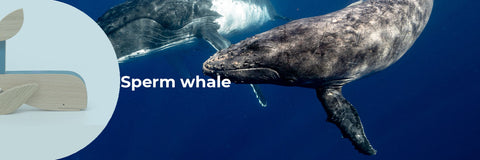The sperm whale (or cachalot) is part of our latest Polar stories collection. In it, we’ve gathered the most attractive species from the Arctic circle and Antarctica. We wanted to have them all in one place, something that could never happen in reality. Sperm whales are ocean predators, mammals who are found in all deep oceans, from the equator to the edge of the pack ice in the Arctic and Antarctic. They are named after the waxy substance – spermaceti – in their heads, which I will tell you about below.

photography: Elianne Dipp
The sperm whale or cachalot is the largest of the toothed whales and the largest toothed predator. Males can weigh up to 50 tons, their head is about one-third of their body length, and they are the animals with the largest brains on Earth. They have an extremely narrow lower jaw. They only have teeth on that lower jaw, and in their upper jaw, they have recesses or even holes.
Sperm whales are one of the few whales that have a very significant difference in size between males and females. Males typically are between 15 and 18 meters long and weigh between 39,000 to 49,800 kg, while females typically are 8 to 17 meters long and weigh 11,800 to 18,000 kg.
A cachalot’s brain is considered the largest on the planet. It weighs about 9 kg. Those big brains are also housed in huge heads. Sperm whale heads by ratio are huge, being about one-third of the body length. When whalers found the wax-like substance in the cachalot’s heads, they assumed it had some kind of reproductive function and dubbed the stuff “spermaceti” (Latin for “whale seed”). For centuries, naturalists have tried to discern its biological role. Some suspect that spermaceti helps regulate buoyancy while others think it evolved as a shock-absorber to protect the brains of hormonal, head-butting males during mating season. A third hypothesis focuses on sound—perhaps it helps shape long-distance sperm whale vocalizations.

photography: Emma Li
The females cooperate to protect and nurse their young. Females give birth every four to twenty years, and care for the calves for more than a decade. A mature sperm whale has few natural predators, although calves and weakened adults are sometimes killed by pods of killer whales (orcas).
Socially, female sperm whales form tight-knit communities, while males lead relatively lonely lives after reaching maturity. As a matriarchal species, cachalots tend to form groups of adult females and younger whales so the younger ones can learn from the females to become successful adults. The groups, known as pods, usually consist of about 15 to 20 whales. Male whales prefer to swim independently or change groups regularly. They have calls with a unique sound signature that they use to search for a potential mate.

photography: Herman Segui, Inchs
Sperm whales are feeding all the time. They can eat about three percent of their body weight daily, sometimes up to two tons of food! Whales love eating squids.
Echolocation is a method used by whales, bats and dolphins to determine locations of objects using reflected sound. It allows the animals to navigate and hunt in the dark, to recognize friends and foes, and to avoid obstacles. Sperm whales use echolocation that is a bit different and quite complex because of how sound travels through the skull and spermaceti organ. Their clicks help them locate their food across longer distances, acting like biological sonar. Lower grumbly tones help once the food is very close and about to become a meal.

photography: Inchs
Whales are world class divers. Cachalots have been recorded descending to depths of over 3,280 feet and can go 90 minutes between breaths.
Smokeless candles can be made out of the spermiceta material in the whale’s head. This almost drove these majestic mammals into extinction. During the 18th and early 19th centuries, spermaceti-fueled lanterns, streetlights, and lighthouses were in high demand. Sadly, meeting that demand called for the deaths of an estimated 236,000 sperm whales. This overhunting eventually sent the industry into chaos as cetaceans grew progressively scarcer. Fortunately for consumers and sperm whales, an alternative energy source soon came to light when Canadian geologist Abner Gesner developed a longer-lasting kerosene-based lamp fuel which all but eradicated the sperm whaling trade. Nowadays, deep-sea oil and gas extraction can cause multiple issues for sperm whales such as loss of hearing, water pollution from hydrocarbons, and increased risk of being hit by ocean vessels.

If you see a beached whale corpse, you might wanna consider stepping back. Decaying cadavers have, on numerous occasions, erupted violently in front of stunned human audiences. Gasses released inside the animals’ bodies during decomposition are known to build up & rip through flesh in a powerful burst of malodorous airborne entrails.
Sources: mentalfloss, animalshowstuffwork, nwf, wikipedia


